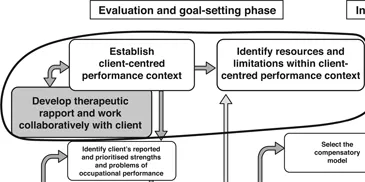
eBook - ePub
Implementing Occupation-centred Practice
A Practical Guide for Occupational Therapy Practice Learning
Karina Dancza, Sylvia Rodger, Karina Dancza, Sylvia Rodger
This is a test
Compartir libro
- 302 páginas
- English
- ePUB (apto para móviles)
- Disponible en iOS y Android
eBook - ePub
Implementing Occupation-centred Practice
A Practical Guide for Occupational Therapy Practice Learning
Karina Dancza, Sylvia Rodger, Karina Dancza, Sylvia Rodger
Detalles del libro
Vista previa del libro
Índice
Citas
Información del libro
This practical text supports occupational therapy students and educators as they navigate the opportunities and challenges of practice learning. Reflecting contemporary and innovative occupation-centred practice, it sets out a step-by-step guide to using this knowledge across a range of settings. The clear structure, templates, examples and strategies it presents demonstrate how contemporary theory can be used to inform and guide practice.
Implementing Occupation-centred Practice is an essential resource for occupational therapy students during their placement preparation and throughout their placement. It also serves as a tool for practice educators who are looking for assistance in structuring learning for their students.
Preguntas frecuentes
¿Cómo cancelo mi suscripción?
¿Cómo descargo los libros?
Por el momento, todos nuestros libros ePub adaptables a dispositivos móviles se pueden descargar a través de la aplicación. La mayor parte de nuestros PDF también se puede descargar y ya estamos trabajando para que el resto también sea descargable. Obtén más información aquí.
¿En qué se diferencian los planes de precios?
Ambos planes te permiten acceder por completo a la biblioteca y a todas las funciones de Perlego. Las únicas diferencias son el precio y el período de suscripción: con el plan anual ahorrarás en torno a un 30 % en comparación con 12 meses de un plan mensual.
¿Qué es Perlego?
Somos un servicio de suscripción de libros de texto en línea que te permite acceder a toda una biblioteca en línea por menos de lo que cuesta un libro al mes. Con más de un millón de libros sobre más de 1000 categorías, ¡tenemos todo lo que necesitas! Obtén más información aquí.
¿Perlego ofrece la función de texto a voz?
Busca el símbolo de lectura en voz alta en tu próximo libro para ver si puedes escucharlo. La herramienta de lectura en voz alta lee el texto en voz alta por ti, resaltando el texto a medida que se lee. Puedes pausarla, acelerarla y ralentizarla. Obtén más información aquí.
¿Es Implementing Occupation-centred Practice un PDF/ePUB en línea?
Sí, puedes acceder a Implementing Occupation-centred Practice de Karina Dancza, Sylvia Rodger, Karina Dancza, Sylvia Rodger en formato PDF o ePUB, así como a otros libros populares de Medicine y Occupational Therapy. Tenemos más de un millón de libros disponibles en nuestro catálogo para que explores.
Información
Part I
Foundations of Occupation-Centred Practice
Chapter 1
Guide to the Book
Occupational therapy is about the creation of health through the vital human need to be occupied (Hooper, 2006). Within occupational therapy education, students and educators explore the relationship between occupation, health and well-being. On the surface this relationship may seem to be straightforward, but when we apply these concepts in real-life situations we discover them as troublesome, changeable and filled with contradictions and tensions.
Implementing occupation-centred practice: a practical guide for occupational therapy practice learning supports the application of contemporary theory about the relationship between health and well-being to the practice of occupational therapy. Learning through doing is promoted in this step-by-step guidance for today’s occupational therapy students and educators (supervisors).
The idea for this book developed within my own practice as an occupational therapy educator. I was conscious of wanting to support occupational therapy students consolidate their understanding of occupation and its value for health and well-being during their practice learning experiences (placements). In doing this, however, I found that applying an ‘occupation-centred’ perspective was indeed troublesome, changeable and filled with contradictions and tensions.
From this place of discomfort I embarked on my doctoral research investigating student learning of occupation-centred practice (Dancza, 2015). Five years and four action research cycles later, I was much better informed about how students learn in practice and what supports and challenges this learning. This book was born out of these experiences and the collaborations with students and educators, both within my own university in the United Kingdom and my colleagues internationally. I am particularly grateful to my co-editor, supervisor, mentor and friend Professor Sylvia Rodger, without whom I would never have started or persisted on this journey.
Practice learning takes many forms. In this book we have illustrated how concepts and strategies about occupation-centred practice can be applied within established occupational therapy services and occupational therapy roles which are in new areas of practice (role-emerging or project areas). While many aspects apply in all placement structures, at times there are differences which we will consider separately.
To present a little certainly within the troublesome and changeable context of practice learning, this book offers students and educators a coherent occupational therapy process from beginning to end. At times this might seem prescriptive, particularly when we explore the use of occupational performance analysis as a key assessment tool and a way to structure our professional reasoning and reporting. Our experience has shown that when students are learning about these important concepts they need a firm foundation which they can logically follow. Without a firm foundation, it is more difficult for students to appropriately select which theories and tools to use. However, once they feel confident in an occupational therapy process they can adapt, change and deviate from this foundation as their understanding develops.
The book is presented in three parts, each with a different focus:
- – Part I outlines our contemporary understanding of occupation-centred practice and presents reminders of some of our occupational therapy models. We then present the ‘engine house’ of occupational therapy with the key tools of occupational profiling, activity and occupational performance analysis, including practical templates and examples. This section is designed to help students and educators develop a collective understanding of what it means to practice in an occupation-centred way.
- – Part II uses the Occupational Therapy Intervention Process Model (OTIPM: Fisher, 2009) and practical examples to guide students and educators through each stage of the occupational therapy process. The OTIPM (Fisher, 2009) was selected as it has a clear and consistent focus on occupation in each step of the process. This model can be used with other occupational therapy models, which is important as students and practice areas often use a range of resources. Educators are encouraged to support students contextualise the information to their own practice learning contexts as this is critical in supporting students’ learning. Key areas which benefit from contextualisation are summarised in Appendix 1.1 and referenced as ‘educator examples here’ and indicated by this image throughout Part II.

- – Part III is focused on supporting educators in their role as supervisors. We commence this section with a demonstration of how educational theory can help us understand practice learning and develop enriched learning opportunities. We then use six case study examples of the implementation of this book from across established and non-established occupational therapy practice learning settings. It is based on examples shared by educators who have used a draft of this book in their own supervision with occupational therapy students. These case studies offer fascinating insights into the successes and challenges of practice learning, with practical tips for making the most of these experiences. Moreover, illustrated in Part III is how the OTIPM (Fisher, 2009) can be used successfully even if it is less well known to students or educators.
As you may see from the overview, this book is intended to support both students and educators. The Part I chapters are relevant for both students and educators as they offer foundation knowledge to create a shared understanding of occupation-centred occupational therapy. Part II focuses mainly on students with the step-by-step guide to practice learning. However, suggestions are also presented for educators to support their guidance of students throughout the occupational therapy process. Part III is written with the educator in mind. It offers an introduction to educational theories applied in occupational therapy practice learning and provides examples through case study illustrations. All chapters are, however, not exclusive to students or educators. Having both educator and student ‘on the same page’ can support understanding of each other’s perspectives. Using the book in supervision discussions can help maintain a clear focus for all involved.
To support occupational therapy students and educators navigate practice learning opportunities, this book is enhanced with learning features to reinforce understanding of key topics. There is a Glossary (beginning on p. 293) which outlines how we will use terms throughout this book. We have attempted to include synonyms as we are aware of the array of terms used internationally to describe practice learning. Additional features of this book to look out for include:
| Intended chapter outcomes | These intended chapter outcomes offer a summary of what you will learn within the chapter. | |
 | Stage in the OTIPM | Stage in the OTIPM |
  | Activity | Throughout the book there are suggested activities (indicated by images such as those shown here) which are designed to support students consolidate their learning of the topics covered in the section. |
 | Educator examples here | We have also pointed out throughout the book where we think it is helpful for educators to offer specifi c suggestions or examples to students about their own practice context. These are indicated by the ‘educator examples here’ and image and are summarised in Appendix 1.1. |
| Chapter summary | Each chapter concludes with a summary of the main points discussed to help reinforce le... | |